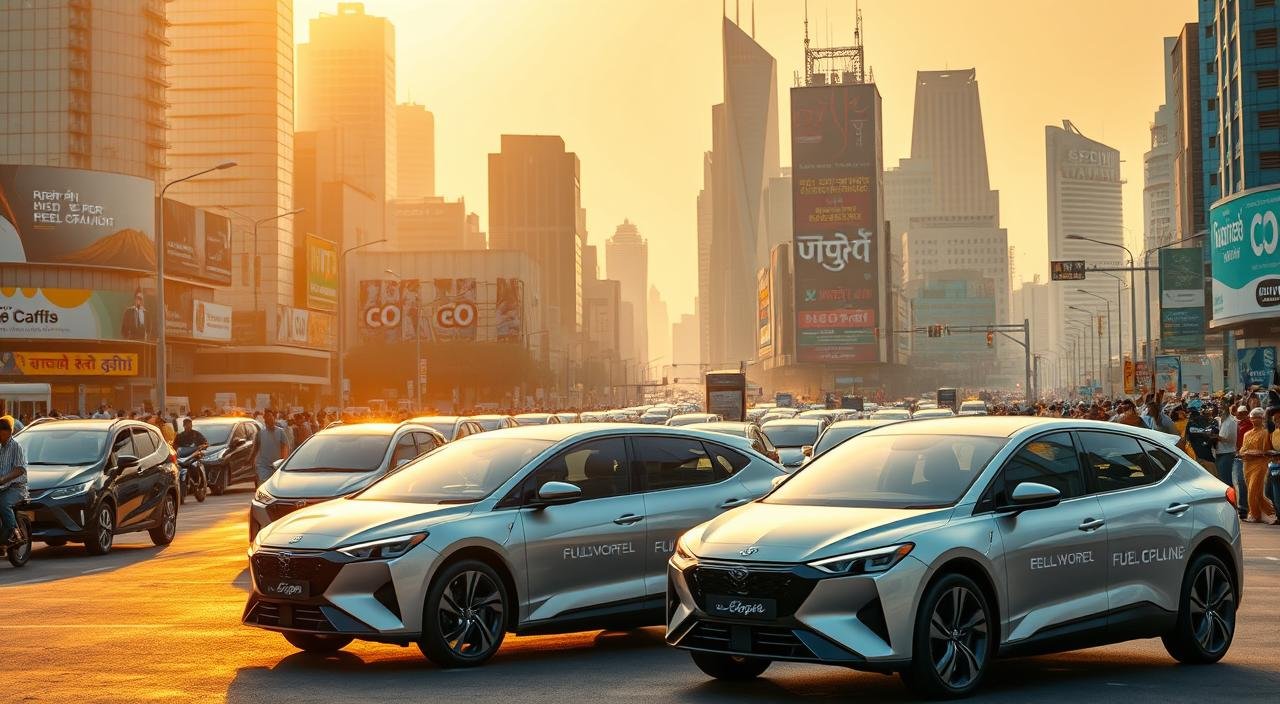
Oct
The Indian car market is on the verge of a big change. The government has announced a 5% GST rate for fuel-cell cars, starting September 22, 2025. This move puts hydrogen vehicles on the same level as petrol and diesel cars, changing the game.
Five key fuel-cell vehicles are set to hit the Indian market. Thanks to the lower GST rate, these cars will be more affordable for people looking for green options. This is a big win for those wanting to switch from traditional engines.
Now is the perfect time for this change. Global car makers are adding more fuel-cell models to their lines. With the 5% GST, fuel-cell cars in India can compete with traditional cars on price. This move shows India’s dedication to hydrogen technology in the car industry.
Key Takeaways
- India reduces GST on fuel-cell vehicles to 5%, matching rates for petrol and diesel cars
- Five hydrogen vehicles are prime candidates to launch in India following the tax benefit
- The policy takes effect September 22, 2025, making FCVs more affordable for buyers
- Fuel-cell cars now enjoy equal tax treatment with conventional vehicles for the first time
- Major automakers are preparing to introduce hydrogen models to capitalize on the incentive
- The GST reduction could accelerate India’s shift toward zero-emission transportation
Understanding Fuel-Cell Technology
Fuel-cell technology is a big step forward in cars, making them cleaner and more efficient. In India, people are looking for better ways to travel than old gas engines. FCVs are a top choice because they use hydrogen to make electricity, leading the way in green cars.
What Are Fuel-Cell Vehicles (FCVs)?
FCVs run on hydrogen fuel cells, making electricity from hydrogen and oxygen. They don’t burn gas like regular cars, so they only make water vapor and heat. This means no big batteries are needed, unlike electric cars.
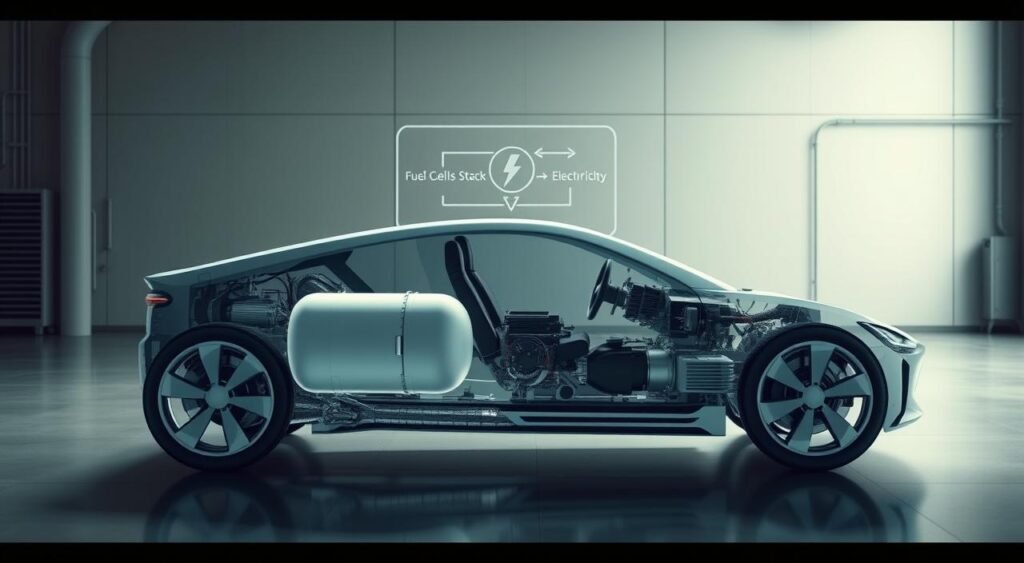
How Do Fuel Cells Work?
Fuel cells work by breaking down hydrogen into protons and electrons. The electrons make electricity for the car’s motor. Oxygen and the protons make water vapor, the only thing these cars emit.
Key Benefits of Fuel-Cell Technology
Hydrogen cars have many good points:
- Rapid refueling: Fill up in just 3-5 minutes, like gas cars
- Extended range: Go 400-600 kilometers on one tank
- Zero emissions: Only make water vapor
- Energy efficiency: Use 60% of fuel energy for power
- Quiet operation: Make very little noise
| Feature | FCVs | Traditional Vehicles |
|---|---|---|
| Refueling Time | 3-5 minutes | 5-7 minutes |
| Emissions | Water vapor only | CO2, NOx, particulates |
| Energy Efficiency | 60% | 20-35% |
| Range per Tank | 400-600 km | 500-800 km |
The Current State of Fuel-Cell Cars in India
The Indian car market is changing, moving from old engines to new, cleaner ones. Electric cars are getting popular, but fuel-cell cars are also gaining attention. The car industry in India, worth over $100 billion, is looking into hydrogen cars as a green option.
Overview of the Indian Automobile Market
India has a huge car market, with over 3.8 million cars sold every year. Big names like Toyota, Hyundai, and Tata Motors lead the market. Toyota, for example, has 12 models, but no fuel-cell cars yet.
People are starting to want cleaner cars because of pollution and bad air in cities. This interest could help fuel-cell cars become more common in India.
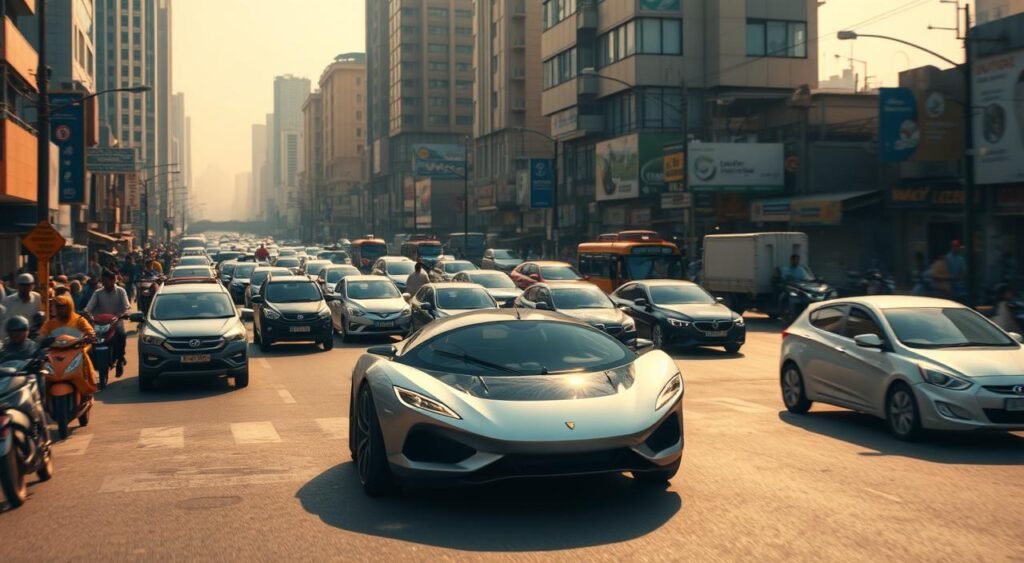
Government Policies Supporting FCVs
The government is backing hydrogen cars with new rules. They want to make fuel-cell cars cheaper to buy. In 2022, the government started a program with Toyota to test hydrogen cars.
Some key policies include:
- A new plan to make more green hydrogen
- Help for companies making fuel-cell cars
- Money for building hydrogen stations
- Tests in some cities to see how well they work
Challenges Facing FCV Adoption in India
Fuel-cell cars in India face big challenges. The biggest one is the lack of places to fill up with hydrogen. Hydrogen stations need special equipment and safety measures.
Other problems are the high cost of these cars, not many people know about them, and electric cars are also popular. The car industry, government, and others need to work together to make hydrogen cars a reality in India.
Financial Implications of GST on Fuel-Cell Vehicles
The introduction of a 5% GST rate for fuel-cell vehicles is a big deal for India’s car market. This lower tax makes these eco-friendly cars more affordable than regular cars. It means buyers can get advanced hydrogen technology at a better price.
What is GST and How Does It Work?
Goods and Services Tax (GST) is India’s single tax system that replaced old taxes. For cars, GST rates change based on the car’s type and features. Most cars face a GST rate between 18% and 28%, with extra taxes making it even higher.
The 5% GST for fuel-cell vehicles is the lowest tax for cars in India. This lower tax is a big help for these cars, which are good for the environment. It encourages more people to buy them.
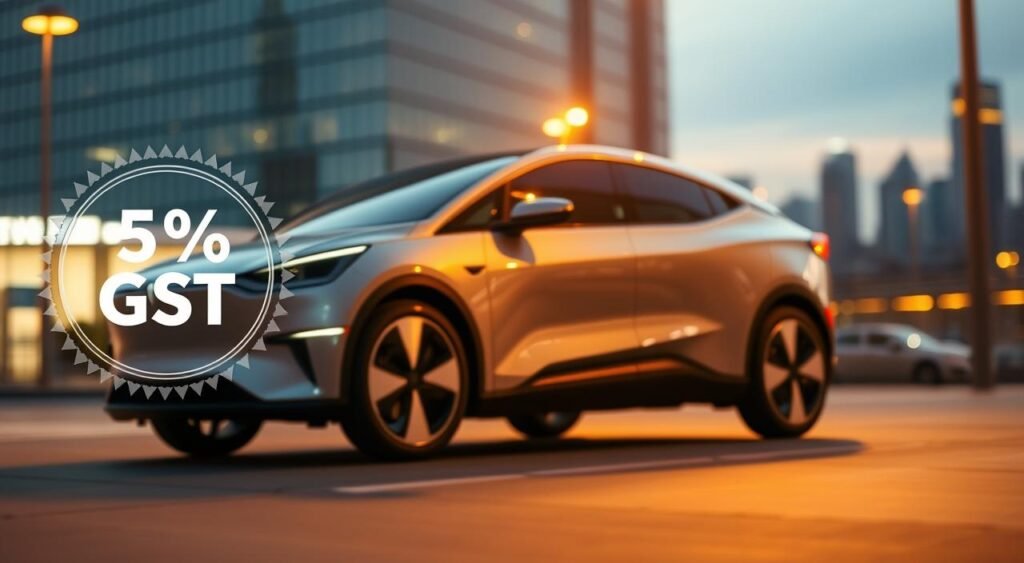
Impact of 5% GST on FCV Pricing
The lower GST rate saves a lot of money for buyers. For example, a fuel-cell car priced at Rs. 60 lakh gets a GST of just Rs. 3 lakh. This is much less than the taxes on regular luxury cars.
Comparisons with Other Vehicle Categories
| Vehicle Category | GST Rate | Additional Cess | Total Tax Impact |
|---|---|---|---|
| Fuel-Cell Vehicles | 5% | 0% | 5% |
| Electric Vehicles | 5% | 0% | 5% |
| Petrol/Diesel Cars | 28% | 1-20% | 29-48% |
| Hybrid Vehicles | 28% | 15% | 43% |
Fuel-cell vehicles now have the same tax benefits as electric vehicles. This makes them the most affordable eco-friendly cars to buy. They also get extra state incentives and lower fees in many places.
Five Fuel-Cell Vehicles Emerging in India
India’s car market is changing fast. Big names are getting ready to bring hydrogen cars to the roads. These cars use new tech that could change how we travel. Let’s look at the top FCVs that might get cheaper soon.
Toyota Mirai: A Trailblazer in FCVs
The Toyota Mirai is a leader in hydrogen cars worldwide. It’s a sleek sedan with over 180 PS power. It can go 600-650 kilometers on one tank, making long trips easy.
What’s cool about the Mirai is how fast it refuels. Just five minutes to fill up. It’s been improved over the years, making it even better.
Hyundai Nexo: An Innovative Approach
Hyundai’s Nexo is a mid-size SUV, like the Tucson. It goes over 700 kilometers on a single tank. It also refuels quickly, in just five minutes.
This SUV is great for families. It’s big and has the latest fuel-cell tech. It’s a top choice for those wanting a big, green car.
Honda Clarity: Features and Benefits
Honda’s CR-V FCEV is different. It has a hydrogen fuel cell and a 17.7 kWh battery. This combo gives it a 450-kilometer range.
It’s special because you can use electric power too. This makes it very versatile, unlike most FCVs.
Tata Motors’ Future Projections
While big brands lead, Tata Motors is also working on hydrogen cars. They see the value of fuel cells for India. They’re making cars that fit India’s needs and infrastructure.
How 5% GST Could Boost FCV Sales
The introduction of a 5% GST rate for fuel-cell cars in India is a big deal. It makes fuel-cell cars more affordable for both makers and buyers. This could change the game for clean energy vehicles in the market.
Potential for Increased Adoption Rates
The 5% GST rate lowers the cost of fuel-cell cars in India. This makes them more appealing to a wider range of people. Electric vehicles, on the other hand, face GST rates between 12% to 28%.
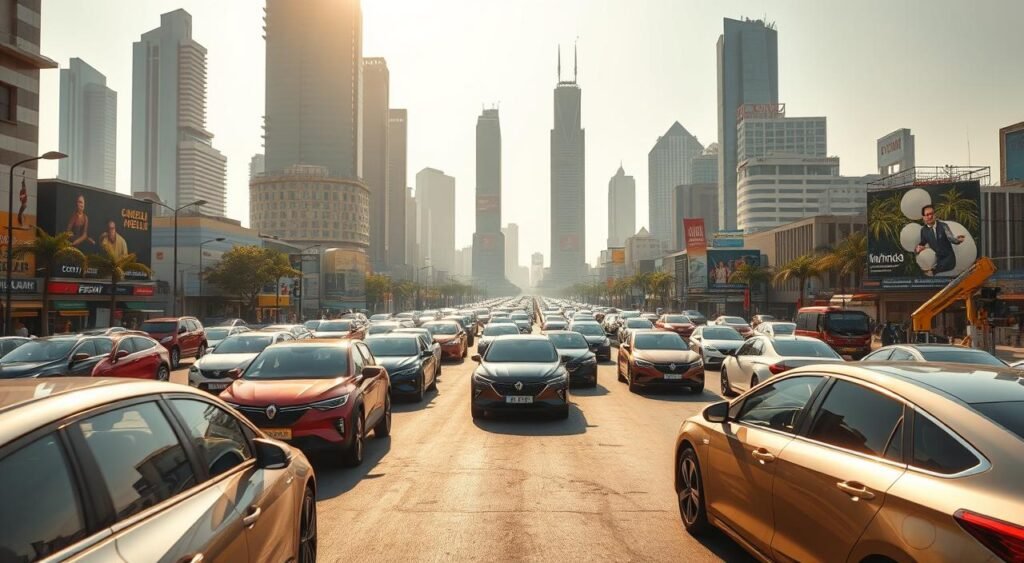
Lower taxes could lead to a 30-40% increase in FCV adoption in the first two years. Fleet operators and corporate buyers are interested in FCVs. They like the quick refueling and longer driving ranges compared to electric cars.
Encouragement for Manufacturers and Investors
The reduced GST rate shows India’s commitment to hydrogen technology. Big names like Toyota and Hyundai are thinking about bringing their hydrogen models to India. The tax benefits make it easier to produce and sell these cars locally, attracting more investment.
Consumer Awareness and Education
For FCVs to succeed, people need to understand their benefits. Zero tailpipe emissions, fast refueling, and long driving ranges are key. Industry groups and the government are working on campaigns to spread the word about these advantages and the 5% GST rate.
Environmental Impact of Fuel-Cell Vehicles
Fuel-cell vehicles are a big step forward in clean energy cars. They help India move towards a greener future. Unlike gas cars, FCVs only release water vapor, not harmful pollutants.
This is great news for India’s air quality and its environmental goals.
Reducing Carbon Emissions
Fuel-cell vehicles don’t have tailpipe emissions, making them eco-friendly cars. Each FCV can cut down about 4.6 metric tons of CO2 a year. This is a big deal for cities like Delhi and Mumbai, which are really struggling with air pollution.
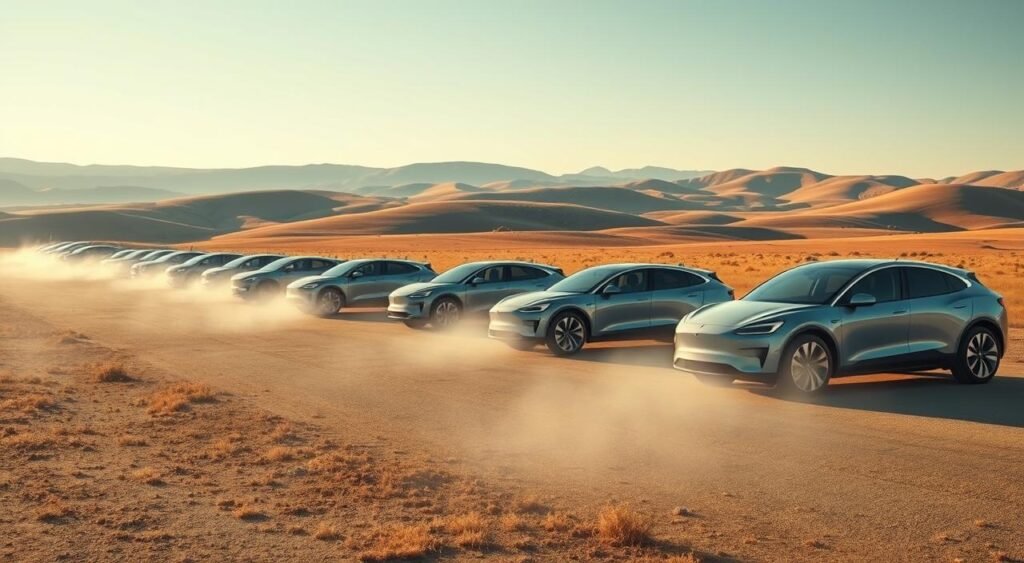
The Role of Renewable Energy in FCVs
The good news about green vehicles goes beyond zero emissions. If hydrogen is made from solar or wind power, FCVs are totally carbon-neutral. India’s growing solar farms in places like Rajasthan and Gujarat are perfect for making clean hydrogen.
Long-term Sustainability Benefits
FCVs have big advantages over electric cars in how they affect the environment. They don’t have the lithium mining and battery disposal issues. They also need fewer rare earth materials and last longer.
As India builds its hydrogen network, these clean energy cars will be key to reaching its 2070 net-zero emissions goal.
FCVs vs. Battery Electric Vehicles (BEVs)
The Indian car market is at a turning point. It’s between fuel-cell vehicles and battery electric vehicles. Each has its own benefits for those who care about the environment. Knowing the differences helps people choose the right car for them.
Comparing Performance and Efficiency
Fuel-cell vehicles are quick to refuel, taking only 3-5 minutes. This is much faster than charging electric cars, which can take hours. They also have a long range, up to 820 kilometers per tank, beating many electric cars.
Battery electric vehicles are better at using energy, turning 77% of it into power. Fuel-cell cars are about 60% efficient. Both types don’t emit any pollution, making them good choices for clean energy.
Cost Considerations and Long-term Value
There’s a big price difference at the start:
| Vehicle Type | Average Price Range (INR) | Fuel Cost per 100km | Maintenance Frequency |
|---|---|---|---|
| Fuel-Cell Vehicles | 50-65 lakhs | ₹400-500 | Every 10,000 km |
| Battery Electric Vehicles | 15-35 lakhs | ₹80-150 | Every 15,000 km |
BEVs are cheaper to run, which appeals to those watching their budget. Fuel-cell cars need less battery replacement, which could save money in the long run, even if they cost more upfront.
Infrastructure Needs for Both Technologies
Building more charging stations is key for both types. India had over 1 million EV charging points by 2019. But, hydrogen cars have fewer places to refuel.
Setting up hydrogen stations is expensive, costing ₹15-20 crores each. EV charging is easier to expand, with many people able to charge at home. Both need more stations to become more popular in India.
The Role of Government in Promoting FCVs
The government is key in shaping the future of fuel-cell cars in India. They are making policies and partnerships to help hydrogen cars grow. The 5% GST rate is a big step towards making cars more affordable and sustainable.
Incentives for Consumers and Businesses
The Indian car industry is getting a lot of support from the government. The 5% GST rate makes fuel-cell cars cheaper than regular cars. This can save people around ₹5-10 lakhs on high-end FCVs.
- Direct purchase subsidies under the FAME scheme
- Tax deductions for businesses adopting hydrogen fleets
- Reduced road tax and registration fees in select states
- Priority parking and toll exemptions for FCV owners
Collaborations with Automotive Manufacturers
Partnerships between the government and car makers are speeding up FCV development. The 2022 pilot program with Union Minister Nitin Gadkari testing the Toyota Mirai was a big moment. These partnerships include research and technology sharing with Toyota and Hyundai.
Future Policy Directions
The future plans include building more hydrogen stations and growing the market. They aim to have 100 stations by 2030 in big cities. The goal is to use green hydrogen made from renewable energy, making cars run on clean energy.
Policy frameworks are being drafted to standardize hydrogen fuel quality and safety protocols, creating a strong ecosystem for the industry’s future.
Public Perception and Acceptance of FCVs
In India, understanding hydrogen vehicles is a big challenge. Many people don’t know how FCVs work or their benefits. We need to clearly explain how they work and address concerns to gain trust.
Common Misconceptions About Fuel-Cell Technology
Many myths about FCVs slow their adoption. Some think they’re dangerous because of fuel storage. But, modern hydrogen tanks are tested and safe.
Another myth is that they can’t go far. The Toyota Mirai can go over 400 miles on one tank, just like gas cars. High costs are also a worry. But, running them is cheaper, and refueling is quick.
Japan and South Korea have shown FCVs are reliable. But, many in India don’t know this.
Educational Initiatives for Consumers
Car makers and governments are working to teach people about FCVs. They offer test drives and share info online. They also train dealers and service centers.
Success Stories from Early Adopters
The 2022 Toyota Mirai pilot in New Delhi was a success. Fleet operators were happy with the cars’ performance. Programs in California and Germany offer lessons for India.
Companies using hydrogen vehicles save money and help the environment. This encourages more people to accept them.
The Future of Fuel-Cell Cars in India
India is at a turning point with fuel-cell cars set to change its car scene. A 5% GST cut opens doors for eco-friendly cars to enter the market. Big names like Toyota and Hyundai are getting ready to launch their fuel-cell models. Tata Motors, a local company, is also diving into this exciting tech.
But, there’s a lot of work ahead. We need to plan well and invest in hydrogen infrastructure.
Predictions for Market Growth
Experts think fuel-cell cars in India will grow slowly but surely over the next ten years. The Toyota Mirai and Hyundai Nexo are set to be the first ones on the market. BMW’s iX5 Hydrogen and Honda’s CR-V FCEV are also waiting for the right time to come out.
They predict that by 2030, hydrogen cars could grab 2-3% of the premium car market. This will happen if we have more hydrogen stations and teach people about fuel-cell tech.
Technological Advances on the Horizon
New tech in fuel cells promises better efficiency and lower costs. Engineers are working on better hydrogen storage and using less platinum in fuel cells. The Toyota Crown shows off advanced fuel-cell tech that might come to India.
Improvements in battery tech are also helping fuel cells. They’re making hybrid systems that use both power sources. These changes make eco-friendly cars more suitable for Indian roads and driving habits.
Closing Thoughts on the Importance of FCVs in India
Fuel-cell vehicles are key for India’s clean transport future. The GST cut shows the government’s support for green vehicles, not just battery electric ones. Success needs teamwork between car makers, energy firms, and government to build hydrogen stations.
The path to making fuel-cell cars common in India is long. But, the steps we take today will shape tomorrow’s transport. As India seeks energy freedom and cleaner air, fuel-cell cars are a vital option that deserves our support.
FAQ
What is the new GST rate for fuel-cell vehicles in India?
The GST rate for fuel-cell vehicles in India has been cut to 5%. This change took effect on September 22, 2025. It makes FCVs more affordable, putting them in a better tax position than traditional vehicles.
How do hydrogen vehicles differ from battery electric vehicles?
Hydrogen vehicles use hydrogen as fuel and can refuel quickly, like regular cars. Battery electric vehicles take longer to charge. FCVs have long driving ranges and zero tailpipe emissions, making them eco-friendly and convenient.
Which fuel-cell cars could launch in the Indian automotive industry?
Five FCVs might soon hit the Indian market. These include the Toyota Mirai, Hyundai Nexo, Honda CR-V FCEV, BMW iX5 Hydrogen, and Toyota Crown. They offer various styles and power, from 180 PS to over 400 PS.
What are the main challenges facing clean energy cars adoption in India?
The biggest hurdle is the lack of hydrogen refueling stations. India has many EV charging points but few for hydrogen. Despite government support, building more stations is key for wider adoption.
What are the environmental benefits of green vehicles like FCVs?
FCVs emit no tailpipe emissions, making them better for the environment than traditional cars. They use hydrogen instead of lithium-ion batteries, reducing environmental impact. This supports India’s goal for cleaner energy and lower carbon emissions.
How does the 5% GST benefit compare to other eco-friendly cars?
The 5% GST rate makes FCVs cheaper for buyers. This tax advantage makes premium FCVs like the Toyota Mirai more competitive in India. It’s a big plus compared to cars with higher GST rates.
What role has the government played in promoting fuel-cell cars in India?
The government has backed FCVs with a 5% GST rate and pilot programs. The 2022 Toyota Mirai study shows their commitment. But, more work is needed to improve infrastructure.
How long does it take to refuel a hydrogen vehicle?
Refueling hydrogen vehicles takes just 3-5 minutes, similar to traditional cars. This is a big plus over battery electric vehicles, which take hours to charge. It makes FCVs great for long trips and quick stops.
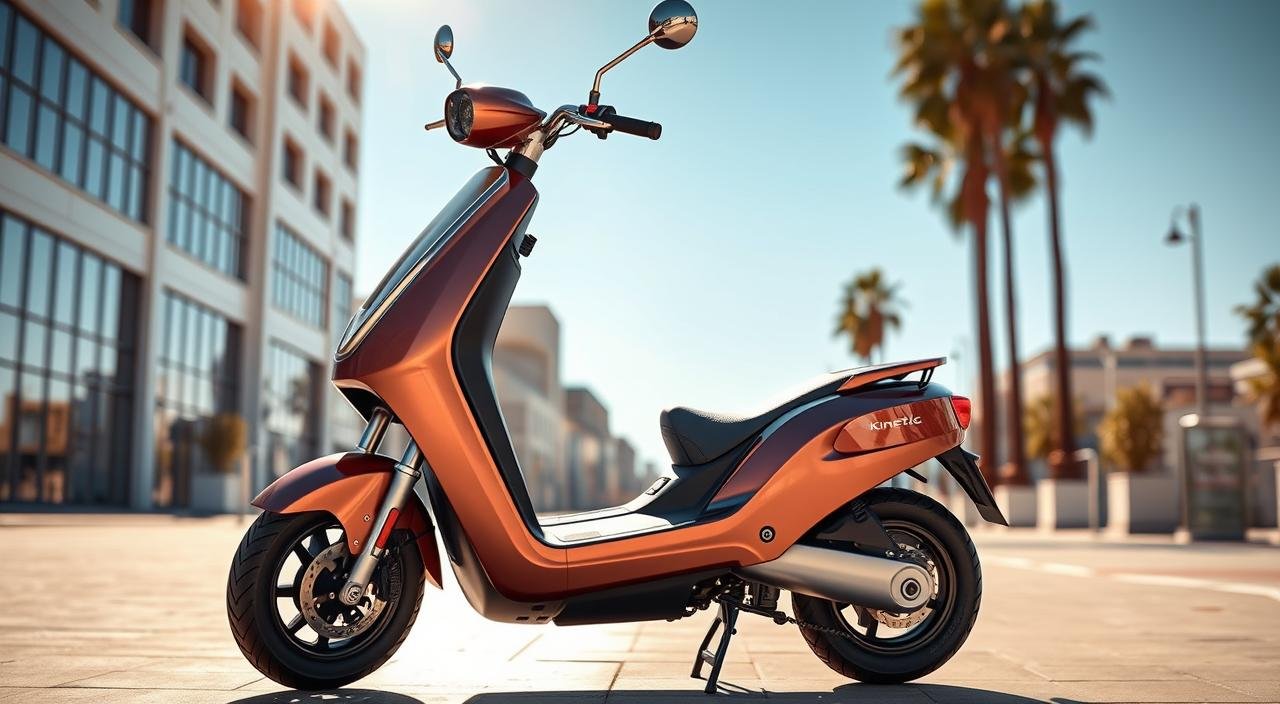
Jul
Can a legendary scooter from the 1980s make a successful comeback in today’s electric age? The Kinetic DX returns as an electric scooter, bringing back memories with modern technology. This iconic two-wheeler once ruled Indian roads in the late 1980s and early 1990s. Now, it’s back with a modern electric twist.
Watts and Volts, the EV division of Kinetic Engineering, has launched this reimagined classic in two variants. The DX and DX+ models start at ₹1.11 lakh (ex-showroom). This electric scooter innovation combines the charm of the original Kinetic Honda DX with today’s environmental needs.
The new electric version enters a competitive market alongside established players like TVS iQube, Ather Rizta, and Ola S1. It promises to deliver performance, affordability, and a strong dose of nostalgia for riders who remember the original. The Kinetic DX returns as an electric scooter at a time when India’s two-wheeler market is rapidly shifting toward sustainable mobility solutions.
Key Takeaways
- The Kinetic DX makes its comeback as an electric scooter after decades
- Two variants available – DX and DX+ priced from ₹1.11 lakh to ₹1.18 lakh
- Manufactured by Watts and Volts, Kinetic Engineering’s EV division
- Competes with premium electric scooters like TVS iQube and Ather Rizta
- Combines nostalgic appeal with modern electric technology
- Targets buyers seeking performance, affordability, and classic design
The Legacy of Kinetic DX: A Look Back in Time
The Kinetic DX is a key part of India’s car history. It first appeared in 1984, starting a new chapter in personal travel. It changed how millions of Indians got around, making lasting memories. Now, as the brand gets ready to launch an electric version, many remember the original’s reliability and charm.
Historical Significance of the Kinetic DX
When Kinetic Honda introduced the DX, it changed the scooter market in India. It had new tech like a self-start and CVT (Continuously Variable Transmission). These features made it easier for more people to ride, showing progress in urban India.

Iconic Features of the Original Model
The original Kinetic DX had features that made it famous:
- Automatic transmission for easy riding
- Electric start button – a luxury at the time
- Comfortable seating for two riders
- Spacious under-seat storage
- Fuel-efficient 100cc engine
The Cultural Impact of Kinetic Scooters
Kinetic scooters were more than just vehicles. They stood for freedom and independence. Families kept these scooters for generations, strengthening bonds. The brand’s influence went beyond just transport, appearing in movies and becoming a part of India’s culture. As it moves to electric models, it keeps the trust and innovation of decades.
Transition to Electric: The Need for Change
The car industry is at a turning point, where caring for the environment meets new tech. Kinetic’s move to make the DX an eco-friendly scooter shows a big change in how people want to get around in India. High fuel prices, pollution, and more people caring about the planet have made electric cars a top choice for city travel.
Riding the Sustainability Wave
Cities in India are dealing with a lot of pollution, and two-wheelers are a big part of the problem. The new Kinetic DX electric scooter tackles these issues directly. It cuts down on emissions, helping riders lower their carbon footprint as they ride through the city. Moving to electric is more than just a trend; it’s a key step towards a greener city life.

Benefits of Electric Scooters
Electric scooters have many benefits over traditional gas-powered ones:
- They cost less to run because electricity is cheaper than gas
- They need less upkeep because they have fewer parts
- They’re quiet, which means less noise pollution
- They don’t emit direct pollutants, making the air cleaner
- There are government perks and discounts to help you buy one
Embracing Modern Technology
The Kinetic DX electric scooter is packed with the latest tech. It has a 4.8 kW BLDC motor and a 2.6 kWh lithium battery. This combo gives quick acceleration and good efficiency. The scooter’s design, with the battery on the floor, makes it stable and safe, lasting for up to 3,500 charge cycles.
Design Evolution: Nostalgia with a Twist
The new Kinetic DX electric scooter blends old charm with new tech. It keeps the original’s spirit but adds today’s style. This mix makes it appealing to all ages.
Classic Aesthetics Versus Modern Design
The scooter’s shape reminds us of the original DX. But, it has modern features like full-LED lights for better visibility and less power use. The chrome flyscreen lights up at night, and the metal body makes it sturdy.

Ergonomics and User Experience
The scooter is designed for comfort. Its seat fits riders of different heights. It’s also good for Indian roads with its ground clearance and stable wheelbase.
The 12-inch wheels and big front disc brake make it safe and easy to stop.
Color Options and Customization
Kinetic DX comes in five colors that mix heritage with today’s look:
| Model Variant | Available Colors | Finish Type |
|---|---|---|
| DX Premium | Red, Blue, White, Silver, Black | Metallic Gloss |
| DX Standard | Silver, Black | Metallic Gloss |
Each color keeps the classic appeal but uses modern paint for a lasting shine.
Powering Forward: The Electric Motor Revolution
The Kinetic DX Returns as Electric Scooter introduces advanced battery tech for better performance and ease. It uses modern lithium-ion batteries for long ranges, making daily rides easy. Switching from petrol to electric is a big step forward, giving riders quiet, efficient rides.
Battery Technology in Current Electric Scooters
Today’s electric scooters have top-notch lithium-ion batteries. These balance weight, capacity, and life span well. They’re tested hard to ensure they’re safe and reliable in all weather.
The Kinetic DX Returns as Electric Scooter has smart battery systems. These systems check on battery health and charge wisely for longer life.
Range and Performance Expectations
Performance varies by model to fit different riders’ needs. The standard DX goes up to 102 kilometers on one charge, reaching 80 km/h. The DX+ boosts range to 116 kilometers and hits 90 km/h.
A special Cruise Lock feature lets riders cruise at under 30 km/h. This can stretch the range to about 150 kilometers on flat ground.

Charging Solutions for Everyday Riders
Easy charging makes owning one a breeze. The Easy Charge system keeps the charger in the glovebox, so you don’t need to carry it. Charging times are great for daily use:
- 0-50% charge: 2 hours
- 0-80% charge: 3 hours
- Full charge: 4 hours
Standard household outlets are all you need for charging. This makes charging at home simple and affordable.
Smart Features: Enhancing the Riding Experience
The new Kinetic DX nostalgia model brings riders into the digital age. It comes with cutting-edge technology that makes every journey better. Smart features turn the classic electric scooter into a smart riding partner, focusing on ease and safety.
Integrated Technology in Electric Scooters
The DX’s tech highlight is its 8.8-inch LCD instrument cluster. It honors the original analog gauges but adds modern functionality. This display shows speed, battery status, and range estimates clearly.
Riders can pick from three riding modes:
- Power Mode – Maximum acceleration for spirited riding
- Range Mode – Optimized efficiency for longer trips
- Turbo Mode – Enhanced performance when you need it most
Safety Features: Lights, Brakes, and More
Safety is key in the electric scooter design. The DX has hill-hold assistance to prevent rollback on inclines. It also has reverse assist for easy parking and full cruise control for long rides.
Connectivity and Apps for Monitoring
The DX+ variant offers a top-notch app experience. It includes geo-fencing for theft protection, detailed ride analytics, and intruder alerts. The Find My Kinetic function helps find your scooter in crowded areas. Voice navigation guides riders without distractions, and updates keep the system current.
The Urban Commuter’s Friend: A Practical Solution
The electric scooter revolution is changing city life. It offers a reliable way to get around, saving money and the planet. The latest scooters come with smart tech and design that make travel easy.
How Electric Scooters Transform Daily Commutes
Electric scooters make city streets easier to navigate. The Kinetic DX has 37-liter storage for your stuff. It also has a keyless ignition and USB charging for your phone.
It has a footrest for passengers and speakers for music. These features show how scooters fit into today’s lifestyle.
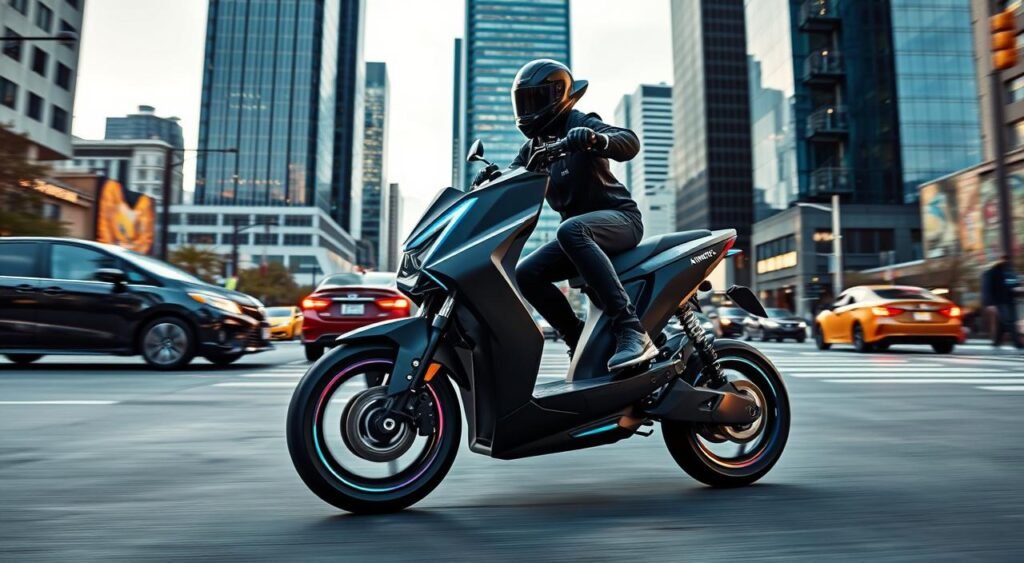
Cost-Effectiveness Compared to Traditional Vehicles
Electric scooters save money over cars and bikes. The Kinetic DX costs between ₹1.11 lakh and ₹1.18 lakh. It’s a bit pricier than the TVS iQube 2.2 kWh, but it has better features.
| Expense Category | Electric Scooter | Petrol Scooter |
|---|---|---|
| Monthly Fuel/Charging | ₹300-500 | ₹2,000-3,000 |
| Annual Maintenance | ₹2,000-3,000 | ₹5,000-7,000 |
| Insurance Premium | ₹3,000-4,000 | ₹4,000-5,000 |
Accessibility for All Urban Dwellers
Electric scooters are for everyone. They’re light and easy to use, perfect for students, workers, and seniors. They’re quiet and easy to charge at home.
This makes them a great choice for cities wanting cleaner transport. They’re a step towards a greener future.
Future of Transportation: E-Scooters in Urban Planning
Cities in India are facing big transportation problems. Traffic jams and air pollution need new solutions. Electric scooters are becoming key for city planning.
The Kinetic DX’s comeback shows a change in thinking about personal transport.
Integrating E-Scooters into Public Transport Systems
Many cities are linking electric scooters with public transit. Riders use them for the “last mile” to their final destination. This helps cut down on car use and makes travel smoother.
Case Studies from Cities Adopted E-Scooters
Bangalore led by adding e-scooter lanes in tech areas, cutting travel time by 30%. Delhi put in charging stations at metro stops to make switching easy. Mumbai set up parking spots for electric bikes along the coast.
- Pune cut carbon emissions by 15% with e-scooter sharing
- Chennai’s IT parks saw 40% less parking problems with e-scooters
- Hyderabad aims for 500 charging points by 2025 in its smart city plan
The Role of Governments in Promotion
State governments give big subsidies for electric vehicles. They offer tax breaks and lower registration fees. This makes electric scooters more affordable.
They also build special lanes and charging spots. Supportive policies help companies like Kinetic, aiming for 40,000 units by 2026 with a ₹177 crore investment.
Community and Culture Around Electric Scooters
The Kinetic DX Returns as Electric Scooter does more than just move people around. It brings people together, creating a community where everyone shares stories and celebrates electric scooter innovation. It connects people across generations, making memories and starting new traditions in the way we move around cities.
The Rise of E-Scooter Sharing Programs
Cities in India are quickly adopting e-scooter sharing programs. Places like Bengaluru, Delhi, and Mumbai see over 50,000 rides every day. This makes electric scooters available to many who can’t afford cars. Kinetic’s wide network of dealers makes it a great choice for these programs.
Building a Community of Enthuasiasts
Local dealerships become places where Kinetic fans and new riders meet. Thousands join WhatsApp groups and social media to share tips and routes. The 300-strong dealer network helps organize meetups and workshops.
Events and Gatherings Celebrating E-Scooter Culture
Every year, rallies honor the heritage and electric scooter innovation. Cities host eco-friendly rides to promote green transport. Kinetic dealerships hold restoration shows, where old and new scooters meet. These events help riders connect and show the benefits of electric scooters to others.
Environmental Impact: Reducing Your Carbon Footprint
The electric revolution is changing how we move around cities. The Kinetic DX Nostalgia is leading the way in India, making the air cleaner. Electric scooters don’t have tailpipe emissions, unlike traditional two-wheelers that pollute cities a lot.
Comparing Emissions: Gas vs. Electric Scooters
Traditional petrol scooters release about 60 grams of CO2 per kilometer. The electric Kinetic DX Nostalgia doesn’t produce any emissions. This is a big difference, considering India’s millions of daily two-wheeler trips.
Electric scooters also reduce harmful pollutants. These pollutants can harm our lungs in crowded cities.
Promoting Eco-Friendly Practices
The Kinetic DX Nostalgia uses advanced LFP battery technology. It’s designed for 3,500 charge cycles. Keeping the battery charged between 20% and 80% helps it last longer and reduces waste.
Charging your scooter is easy and fits into your daily life. You can charge it overnight using a standard outlet. This makes using an electric scooter simple and convenient.
The Future of Clean Transportation
Electric scooters are key to India’s green transportation future. The Kinetic DX Nostalgia shows you can be eco-friendly without giving up on style or performance. As more charging spots appear in cities, electric scooters will become the top choice for clean, affordable city travel.
Consumer Guide: What to Look for in an Electric Scooter
Choosing the right electric scooter means looking at specs, price, and support. The market has many options, each with its own benefits. Knowing what makes a good electric scooter will help you find one that fits your needs and budget.
Key Specifications to Consider
The Kinetic DX sets new standards for electric scooters in India. Look at motor power, battery capacity, and range. The DX has a 4.8 kW BLDC motor for smooth city rides. Its 2.6 kWh LFP battery gives a range of 102-116 km, depending on the model.
Features like regenerative braking, LED lights, and digital displays are important. They make riding safer and more convenient. Also, check for storage options like under-seat space and extra compartments.
Price Range and Value for Money
Electric scooters in India cost between ₹80,000 and ₹150,000. The Kinetic DX is priced well compared to others like TVS iQube and Ather Rizta. Think about the total cost, including electricity and maintenance.
| Model | Price Range (₹) | Key Feature |
|---|---|---|
| Kinetic DX | 90,000-110,000 | Heritage design with modern tech |
| TVS iQube | 95,000-115,000 | SmartXonnect connectivity |
| Ather Rizta | 110,000-125,000 | Largest boot space |
| Ola S1 | 85,000-140,000 | Multiple variants |
Warranty and Customer Support
Long warranties give scooter owners peace of mind. The Kinetic DX has a 9-year/1 lakh km warranty, beating many competitors. Make sure there are authorized service centers near you. Good after-sales support includes updates, spare parts, and trained techs.
Conclusion: Embracing The Future with Kinetic DX Electric Scooter
The Kinetic DX electric scooter is a perfect mix. It’s an eco-friendly scooter that combines old charm with new tech. This makes it a great choice for anyone looking for a reliable ride.
It’s perfect for daily trips and keeps the spirit of the original Kinetic alive. This scooter is a hit with riders of all ages.
Final Thoughts on Nostalgia Meets Innovation
The Kinetic DX electric scooter shows that old brands can change with the times. It has smart features and a good price, making it a top pick for 2025. Its quality is high, and it’s affordable for people in India.
This scooter is special because it blends the old with the new. It stands out among other electric scooters.
Encouragement to Experience the New Model
Try out the Kinetic DX electric scooter for yourself. It’s fast and quiet, thanks to its electric power. You’ll love the mix of classic looks and modern tech.
It has cool features like phone connectivity and regenerative braking. This scooter is both old and new at the same time.
Call to Action for Interested Riders
Check out the Kinetic DX electric scooter at your local dealership. Take it for a spin to see how it changes your commute. It’s a green way to travel without losing out on style or speed.
Join the many riders who prefer clean, efficient travel in India’s busy cities.
FAQ
What is the price range of the new Kinetic DX electric scooter?
The Kinetic DX electric scooter comes in two versions. The basic DX starts at ₹1.11 lakh. The DX+ model, packed with more features, costs between ₹1.17-1.18 lakh (ex-showroom). This makes it a good choice compared to the TVS iQube, which starts at around ₹94,000 for the 2.2 kWh version.
How does the Kinetic DX electric scooter design honor the original model?
The new scooter keeps the classic look of the 1984 Kinetic Honda DX. It has a chrome flyscreen and metal panels for a premium feel. The colors and the 8.8-inch LCD screen pay homage to the original.
What are the range and performance specifications of the Kinetic DX features?
The Kinetic DX has different specs for each version. The DX goes up to 102 km and reaches 80 km/h. The DX+ can go up to 116 km and hits 90 km/h. Both have a Cruise Lock for longer rides.
What makes this electric scooter innovation stand out in sustainable transportation?
The Kinetic DX has a 2.6 kWh battery that lasts a long time. It’s good for the environment because it doesn’t emit anything and charges quickly. Its design also helps reduce pollution in cities.
How does the Kinetic DX serve as an urban mobility solution?
The scooter is great for city travel. It has lots of storage, USB charging, and easy ignition. It also has features like hill-hold and cruise control for easier city driving.
What smart connectivity features does the DX+ variant offer?
The DX+ has a smart app for things like tracking and alerts. It also has Bluetooth, a speaker, and voice navigation. These features make the scooter more convenient and fun to use.
How does the Kinetic DX Nostalgia factor influence buying decisions?
The Kinetic DX name brings back memories for many. It combines old-school charm with new tech. This makes it appealing to both old fans and new buyers looking for a unique ride.
What are Kinetic’s expansion plans for the electric scooter market?
Kinetic aims to make 40,000 units by August 2026. They’re investing ₹177 crore to grow their dealer network to 300. They want to take 6-8% of the market by 2028, making the DX a key player in India’s electric scooter market.
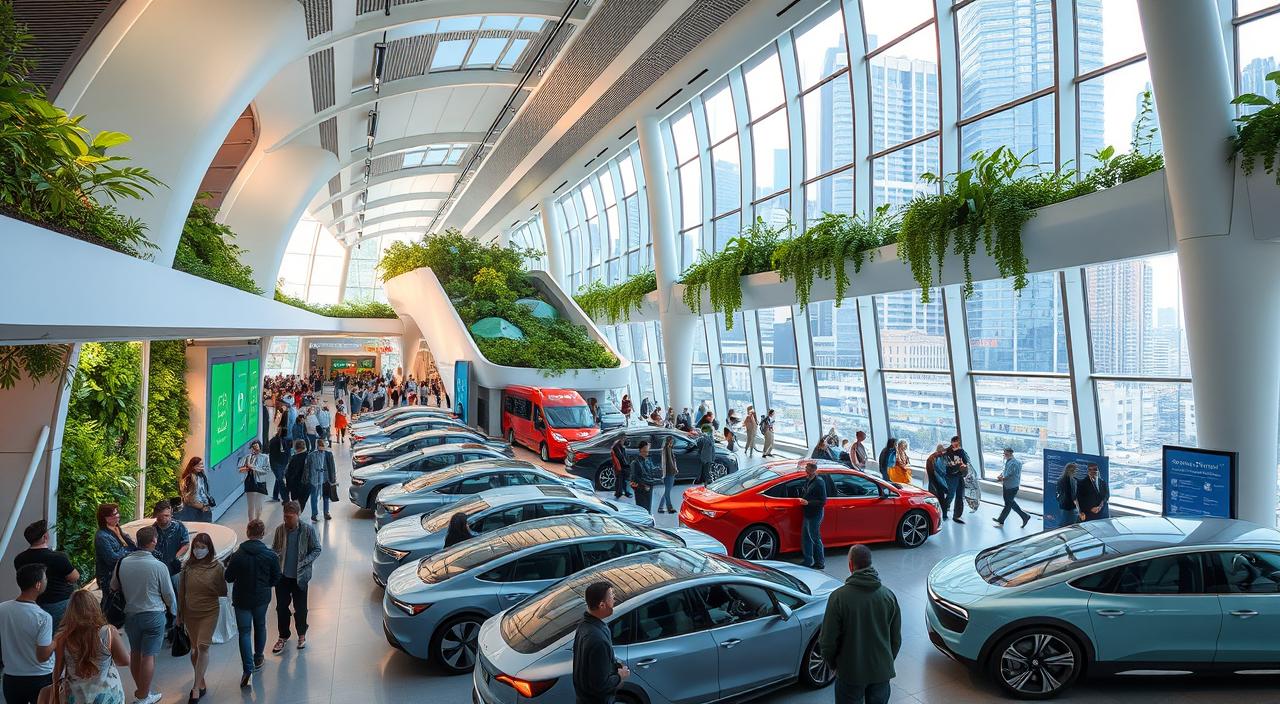
Jan
India is now the world’s third-largest car maker, making over four million cars a year. This puts India right behind China and the United States. The Bharat Mobility Expo 2025 at the Bharat Mandapam in Pragati Maidan, New Delhi, highlights India’s focus on green transport and electric vehicles.
The expo featured exciting new launches. These include the Maruti Suzuki e-Vitara electric SUV and the TVS Jupiter CNG scooter. Yamaha also showed off thrilling adventure bikes. Hero MotoCorp unveiled the Hero Karizma 250, showing India’s innovation in automotive tech.
The Bharat Mobility Expo 2025 is now an annual event, up from biennial. This change shows how fast India’s car industry is growing. With most of India’s people under 35, the expo is key for engaging the youth in green transport.
Key Takeaways:
- India ranks as the world’s third-largest car manufacturer, producing over 4 million cars annually
- The Bharat Mobility Expo 2025 showcases India’s commitment to sustainable transportation and electric vehicles
- Notable launches at the expo include the Maruti Suzuki e-Vitara electric SUV and TVS Jupiter CNG scooter
- The expo has transitioned to an annual event, reflecting the rapid pace of development in India’s automotive sector
- With a young population, India is poised to embrace sustainable transportation solutions for the future
India’s Emergence as a Global Automotive Leader
India’s car and bike industry has grown a lot in recent years. This has made India one of the top car makers in the world. It produces over four million cars and nearly 20 million bikes every year.
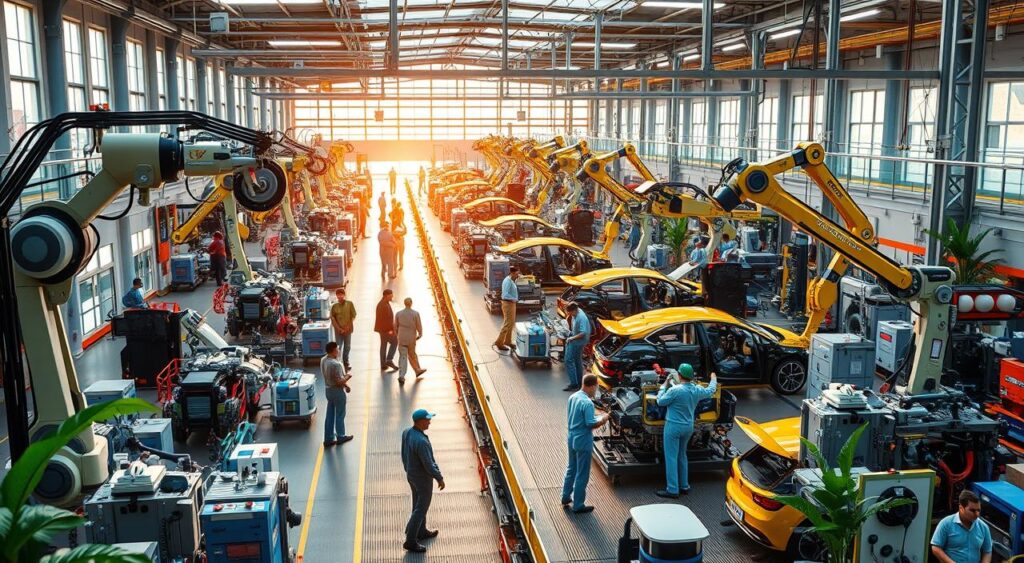
India’s car world changed in the early 1990s when it welcomed big car companies. This move brought in more money and new tech. Now, India is the biggest maker of three-wheelers and tractors, making it a global leader.
Impressive Growth in Car and Two-Wheeler Production
India’s car and bike making has grown a lot. It makes over four million cars every year. The bike market is the biggest in the world, with nearly 20 million bikes made annually.
Rise of the Indian Auto Component Industry
The auto parts industry in India has also grown a lot. Companies are not just growing in India but also selling their products worldwide. This shows they are good at what they do and can compete globally.
| Automotive Sector | Annual Production |
|---|---|
| Cars | Over 4 million units |
| Two-Wheelers | Close to 20 million units |
India is getting even bigger in the car world. It’s making more cars and bikes and its auto parts industry is growing. This means India will keep driving innovation, attracting investors, and shaping the future of cars and bikes globally.
Government Support for the Automotive Industry
The Indian government showed strong support for the automotive industry at the Bharat Mobility Expo 2025. Prime Minister Narendra Modi’s attendance at the opening ceremony highlighted the government’s commitment to the sector’s growth.
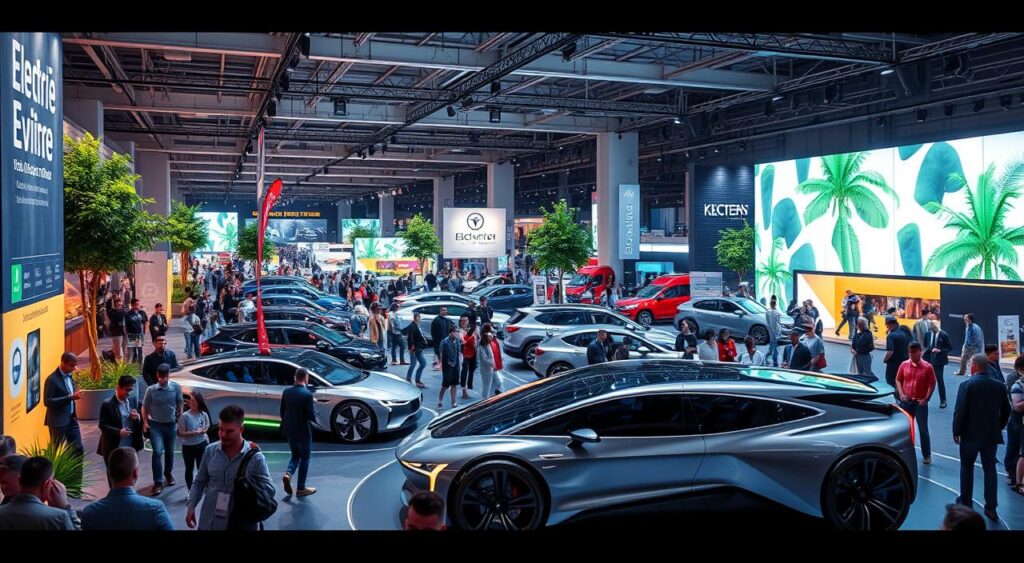
The expo focused a lot on clean emissions and electric vehicles. It showcased many electric cars, showing India’s aim for a greener future. The government’s PLI scheme has helped a lot, creating jobs and boosting sales.
Impressive Growth and Investment
The automotive industry in India has grown a lot, with sales up by about 12 percent. The demand for cars keeps going up. The government’s help has brought in over USD 36 billion in FDI in the last four years.
Electrification and Infrastructure Development
The government is serious about making cars electric. They’ve set aside INR 18,000 crore for electric battery storage. They’re also spending a lot on roads, with INR 11 lakh crore for highways and expressways. Over 70,000 fast chargers are being put up across the country.
| Scheme | Impact |
|---|---|
| PLI Scheme | Generated over Rs 2.25 lakh crore in sales and created more than 1.5 lakh direct jobs |
| FAME-2 Scheme | Subsidized the purchase of over 16 lakh EVs, including 5,000 electric buses |
The government said the Bharat Mobility Expo will now happen every year. This shows their commitment to the industry’s growth. As India moves towards cleaner cars, the government’s support will be key in shaping the future of mobility.
The Power of Social Media in Promoting Bharat Mobility Expo
Social media was key in getting the word out about the Bharat Mobility Expo 2025. With nearly two-thirds of India’s population under 35, young influencers helped spread the news fast. They used various digital platforms to create excitement.
Influencer marketing played a big role. News about the expo spread quickly, reaching millions. Digital marketing strategies, aimed at the tech-savvy youth, drew a huge crowd.

Big automotive brands also helped boost the event’s social media presence. They used their online followers to build anticipation for their new products. Here’s a look at the social media buzz during the expo:
| Platform | Hashtag Mentions | Impressions |
|---|---|---|
| 1.2 million | 50 million | |
| 800,000 | 30 million | |
| 1.5 million | 75 million |
The Bharat Mobility Expo 2025 showed the power of social media promotion and digital marketing. As India keeps embracing technology, social media’s role will only grow. It will shape public opinion and drive participation more than ever.
Evolution of the Auto Expo into Bharat Mobility Expo
The Auto Expo in India has changed into the Bharat Mobility Expo. This change shows how the car industry is evolving. The Bharat Mobility Expo 2025, from January 17 to January 22, brought new car tech to the table. It drew over 5,100 international guests and is expected to welcome 500,000 visitors.
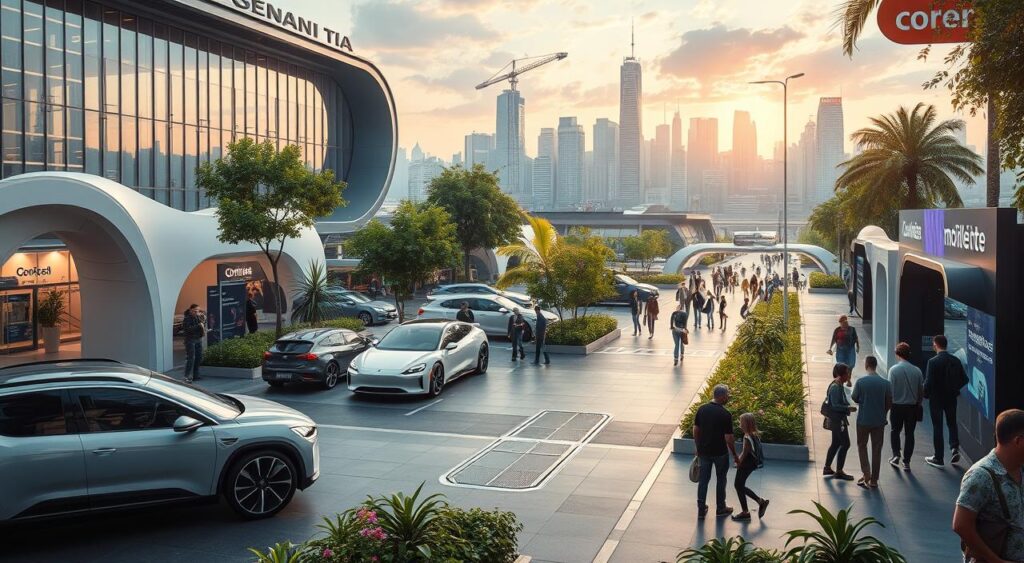
Decentralization of Venues for Better Focus
The Bharat Mobility Expo now has different venues for each part of the car industry. Cars are shown at Bharat Mandapam in Pragati Maidan. Components are at Yashobhoomi in Dwarka, and a third spot is at the India Expo Centre & Mart in Greater Noida. This change helps avoid overcrowding and keeps places clean.
Improved Accessibility and Hygiene
The new setup makes it easier for people to get around and keeps things clean. The car industry is focusing more on being green and clean. This expo’s cleanliness and ease of access make it better for everyone.
| Venue | Focus |
|---|---|
| Bharat Mandapam, Pragati Maidan | Vehicles |
| Yashobhoomi, Dwarka | Component Makers |
| India Expo Centre & Mart, Greater Noida | Additional Venue |
The Bharat Mobility Expo 2025 is a big step forward for car shows in India. It shows India’s growing role in green car tech. With over 100 new car and tech launches, it shows India’s big plans for the future.
Impressive Participation from Major Brands
The Bharat Mobility Expo 2025 was a huge success. Over 1,500 exhibitors from across the industry showed off their latest innovations. The event, held from January 17 to January 22, 2025, covered 200,000 square meters. It attracted over 500,000 visitors, making it a hit.
On the first two days, 90 new products were launched. On the second day alone, 56 new products from 22 brands were unveiled at Bharat Mandapam. An extra 5 launches happened at Yashobhoomi, Dwarka, showing the event’s importance.
Strong Presence of Two-Wheeler Manufacturers
Two-wheeler leaders like Hero MotoCorp, TVS Motor, and Bajaj Auto were there. Honda, Suzuki, and Yamaha also showcased their latest models. Hyundai Motor Company even launched 2 concept models for last-mile mobility, showing its growing importance.
| Manufacturer | Product Launch | Price (ex-showroom) |
|---|---|---|
| BMW | X3 | Rs. 75,80,000 – Rs. 77,80,000 |
| BMW | S 1000 RR | Starting from Rs. 21,10,000 |
| BMW | R 1300 GS Adventure | Starting from Rs. 22,95,000 |
| Omega Seiki Pvt. Ltd. | M1KA 1.0 electric truck | INR 6,99,000 |
Showcasing Electrification Efforts
Electrification was a big focus at the Bharat Mobility Expo 2025. VinFast introduced two EV models, the VF 7 and VF 6, for the Indian market. BYD India showed the fully electric Sealion 7 eSUV. JBM Electric and Eka Mobility presented electric buses, showing a shift towards electric in public transport.
India’s first solar electric car, ‘Eva,’ was also launched. Prices ranged from Rs 3.25 lakh to Rs. 5.99 lakh (ex-showroom). The expo showed the Indian auto industry’s growth and commitment to innovation and sustainability. Events like this will shape the future of mobility in India.
The Rise of Indian Startups in the Mobility Landscape
The entrepreneurial spirit of Indian startups has been a driving force in the mobility landscape. This is true, mainly in the realm of electric two-wheelers. At the Bharat Mobility Expo 2025, these innovative companies have taken center stage. They showcased their cutting-edge products and solutions alongside industry giants.
Ola Electric and Ather are standout performers in the electric two-wheeler segment. Their presence at the expo highlights the growing importance of Indian startups in shaping the future of mobility.
The expo also featured an impressive array of electric two-wheelers from other homegrown brands like TVS and Bajaj Auto. These companies have embraced the shift towards sustainable mobility. They have developed innovative products that cater to the evolving needs of Indian consumers.
| Startup | Product Showcase |
|---|---|
| Ola Electric | Next-generation electric scooters |
| Ather | Smart electric scooters with advanced features |
| TVS | Range of electric and flex-fuel vehicles |
| Bajaj Auto | Innovative electric two-wheelers |
The success of these Indian startups can be attributed to their agility, innovation, and deep understanding of the local market. By leveraging technology and focusing on user experience, they have been able to carve out a niche for themselves in the competitive mobility landscape.
As the demand for sustainable transportation solutions continues to grow, the role of Indian startups in the electric two-wheeler segment is set to become even more prominent. With their entrepreneurial spirit and commitment to innovation, these companies are poised to lead the charge in the ongoing revolution in the mobility landscape.
Bharat Mobility Expo 2025: A Reflection of India’s Growing Confidence
The Bharat Mobility Expo 2025 shows India’s growing confidence despite global challenges. India has shown great resilience and confidence. This is thanks to the positive messaging from leaders, showing a bright future for India.
The expo highlights India’s ability to face global ups and downs. It has over 800 exhibitors and 1.5 lakh visitors each year. It’s a key event for the growth and innovation in the automotive and mobility sectors.
Resilience in the Face of Global Challenges
India’s car industry has grown 12% in the last year, showing great resilience. The growing middle class has increased demand for cars. This has led to over 2.5 crore cars sold each year.
The government’s focus on infrastructure has helped the industry grow. The PLI scheme has boosted sales and created jobs. India has also attracted over 36 billion dollars in foreign investment, showing it’s a great place to invest.
Positive Messaging from Policymakers
The positive messaging from leaders has boosted confidence. The push for clean emissions and electric vehicles has seen a huge increase in sales. Electric vehicle sales have grown 640 times in the last decade.
Initiatives like FAME-2 have supported over 16 lakh electric vehicles. The Indian government’s use of over 1,200 electric buses in Delhi shows its commitment to green transport.
The Bharat Mobility Expo 2025 is a showcase of India’s growing confidence, resilience, and positive outlook. It highlights India’s focus on innovation, sustainability, and self-reliance. The expo is a beacon of India’s bright future in the automotive and mobility sectors.
Conclusion
The Bharat Mobility Expo 2025 has ended, but the future of mobility in India looks bright. Over 1,000 exhibitors from seven countries showcased their latest in sustainable transport and car tech. More than 50,000 visitors, including global leaders, saw the innovations.
With 60+ new products launched, India is serious about cleaner, greener transport. This shows India’s dedication to a greener future. The auto parts sector aims to hit $100 billion in exports in ten years. They also want to use AI for better quality and precision.
The expo was a big success, showing India’s confidence in leading mobility’s future. It was not just a showcase but a sign of India’s growing role globally. The nine shows at the expo gave a full view of the industry’s future.
With government support, Indian startups, and big brands on board, India is ready to lead. The Bharat Mobility Expo 2025 may be over, but the journey to change how we move is just starting.
FAQ
What is the significance of the Bharat Mobility Expo 2025?
The Bharat Mobility Expo 2025 is India’s biggest car show. It shows the future of moving around and makes India a big player in cars and energy. It also shows India’s push for green cars and clean transport.
How has India’s automotive industry grown over the years?
India is now a top carmaker, after China and the US. It makes over four million cars a year. The car and bike world in India has grown a lot, thanks to more cars and bikes being made, and a strong parts industry.
What role does the Indian government play in supporting the automotive industry?
The Indian government really supports cars and bikes. Prime Minister Narendra Modi’s visit to the Bharat Mobility Expo 2025 was a big boost. The government wants clean cars, electric ones, and has made the expo an annual event.
How did social media contribute to the promotion of the Bharat Mobility Expo 2025?
Social media was key in getting the word out about the Bharat Mobility Expo 2025. Young influencers shared updates fast on different platforms. This showed how social media can help spread news quickly.
What changes were made to the Auto Expo format in the Bharat Mobility Expo?
The Auto Expo has changed to the Bharat Mobility Expo. Now, it’s held in different places for better focus and easier access. These changes help avoid problems like too many people and not being clean, making the event better.
Which major brands participated in the Bharat Mobility Expo 2025?
Big names like Hero MotoCorp, TVS Motor, and Honda were at the Bharat Mobility Expo 2025. They showed off their bikes and scooters and talked about going electric.
What role do Indian startups play in the mobility landscape?
Indian startups are big in the car world, mainly in electric bikes. Companies like Ola Electric and Ather are showing off new ideas at the Bharat Mobility Expo 2025. They help make electric cars more popular in India.
How does the Bharat Mobility Expo 2025 reflect India’s confidence in the face of global challenges?
The Bharat Mobility Expo 2025 shows India’s confidence, even with tough times like a weak rupee and jobs being hard to find. India is showing it can handle challenges and is looking forward to a brighter future.
What is the future of mobility in India?
The Bharat Mobility Expo 2025 is setting the stage for a big change in how we move around. With big brands, startups, and government support, India is ready to lead in clean, green transport. It’s all about innovation, new ideas, and a green future.
